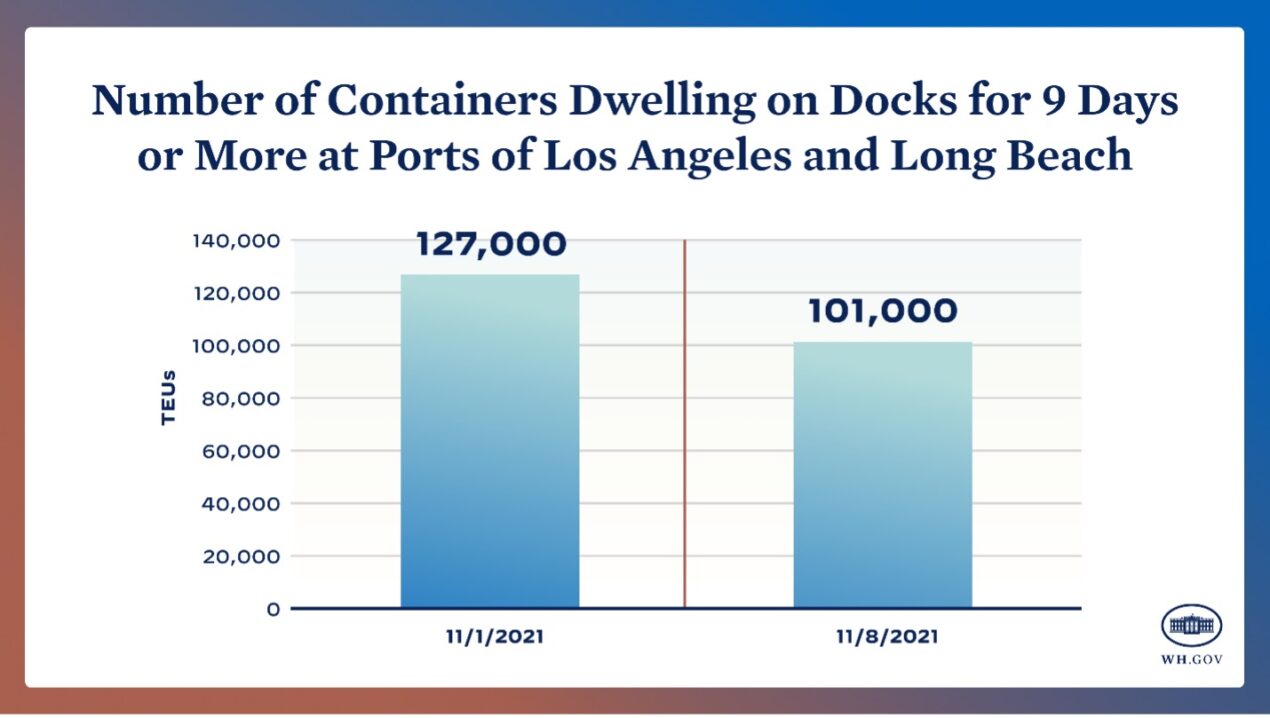Recent Progress and Actions on Port Congestion
Retailers have spent the past few months moving a record number of goods into the country with the help of longshore workers, truck drivers, railroad and warehouse workers. The Ports of Los Angeles and Long Beach—which handle 40 percent of the country’s containerized imports—have moved 17 percent more containers between January and mid-October than they did in 2018, which held the previous record. Simply put, the transportation supply chain is going to move more goods this year than ever before, which has helped store shelves essentially recover to or even exceed their pre-pandemic states.
This historic throughput has led to challenges for importers and exporters including retailers as they work through their busiest season ever and farmers trying to get products to foreign markets. Which is why we’ve been on the case.

Last month, the Ports of Los Angeles and Long Beach and International Longshore and Warehouse Union (ILWU) workers joined together to commit to shift towards 24/7 operations, aimed at boosting both throughput and efficiency at our nation’s ports. Some of the countries’ largest companies joined in as well, committing to move more containers during off-peak hours. Both major railroads responsible for moving goods out of the ports, BNSF and Union Pacific, announced discounts to customers on each container moved by rail during the weekend and Union Pacific also decided to operate its station near the ports 24/7. Port Envoy Porcari has also been leading thrice weekly meetings with terminal operators, shipping lines, and other key stakeholders to identify operational problems and immediate solutions at the two ports.
Our actions to facilitate practical problem solving and collaboration between each link in the goods movement chain is starting to show some early returns:
- Driving Down “Dwell Times”:
- One of the key challenges to restoring velocity and fluidity to the Ports of Los Angeles and Long Beach has been the shrinking amount of space on the ports themselves. While the ports have handled 17 percent more imported containers so far this year compared to the previous record, the amount of space available to store containers is fixed – it has not expanded 17 percent nor has the amount of land in the Southern California warehouse system. This has led to containers piling up at the ports, which slows the entire system down – less space to move containers between docks and ships, less space for trucks to maneuver, and fewer chassis available because containers are sitting on them.
- The average number of days a container spends on the docks has crept up this year, to an average of around six days in September 2021 from under three days pre-pandemic.
- Successfully reducing this “dwell time” figure is key to restoring velocity to the ports. The first step to reducing dwell time was taken by the ports two weeks ago when they announced that they would begin assessing congestion fees on the ocean carriers for containers that dwell on the docks for too long.
- We are now seeing the payoff of that initiative: in just one week, the number of containers that have been dwelling on the docks for at least nine days has fallen over twenty percent according to data provided by the ports. This is an early, but promising sign that each link in the chain is working together to help more goods leave the ports, and to free up more space on the ports.
- Waiving Fees for Night & Weekends:
- Currently, truck drivers pay a fee to enter the ports to pick up cargo. This system, known as Pier Pass, was originally designed to incentivize off peak hours and reduce emissions. However, in recent years the terminal operators who run Pier Pass had converted it to a flat fee.
- The terminal operators have been considering changing the system to create a financial incentive for trucks to use night and weekend hours. If they move forward, their proposal would waive the current fee during nights and weekends for the remainder of the shipping high season.
- By getting more containers picked up during the lower-traffic nights and weekends, trucks would move containers off the docks more efficiently and produce less emissions in the surrounding communities. To be most impactful, terminal operators would need to also fully staff the nighttime and weekend shifts so truck drivers can make effective use of the no-fee period.
- New Retailers join the effort:
- We are also seeing additional retailers join the move towards off-peak operations. Toolmaker Stanley Black & Decker has committed to moving 33 percent of its Los Angeles and Long Beach cargo during the off-peak while clothing retailer Gap Inc. has committed to a 15 percent increase. They join our other partners—Walmart, Target, FedEx, UPS, Home Depot, and Samsung—in supporting a shift towards a 24/7 system. Commitments like this help send a critical demand signal to the rest of the chain to increase hours and efficiency.
- Reducing congestion at the Port of Savannah:
- Ports in both the East and West Coast are experiencing record setting levels of volume. The Port of Savannah, the fourth largest container port in the U.S., has also seen a surge in the number of ships at sea and containers to process. The Georgia Port Authority, with support from the Department of Transportation, will have over $8 million available to establish five pop-up container yards in Georgia and North Carolina. These five yards, accessible by rail and truck, can accommodate more than 500,000 containers over the course of a year or the equivalent of 27 “mega container ships. The Department of Transportation will support the Port of Savannah, and other ports seeking to solve current supply chain disruptions, by providing new flexibility in existing grants.
The progress over the last couple weeks means that a goods movement system that has been working in overtime is also starting to function more efficiently, making it easier to get goods from ship to shelf to your front door, as well as help exporters get their goods to market. But we cannot lose sight of the fact that we have underinvested in this system for decades. That is why the recent passage of the Bipartisan Infrastructure Deal is so important. Not only does it include $17 billion for our ports, but it also will help improve efficiency, reduce costs, and decrease emissions in the movement of goods from dock to rail and rail to truck. And this comes on top of a $5 billion agreement between the U.S. Department of Transportation and the state of California to support port and inland improvements in this critical freight node. Altogether these investments will create good paying jobs and help strengthen U.S. competitiveness for decades to come, making our supply chains more resilient against future shocks.
Source: https://www.whitehouse.gov/briefing-room/blog/2021/11/10/recent-progress-and-actions-on-port-congestion/



